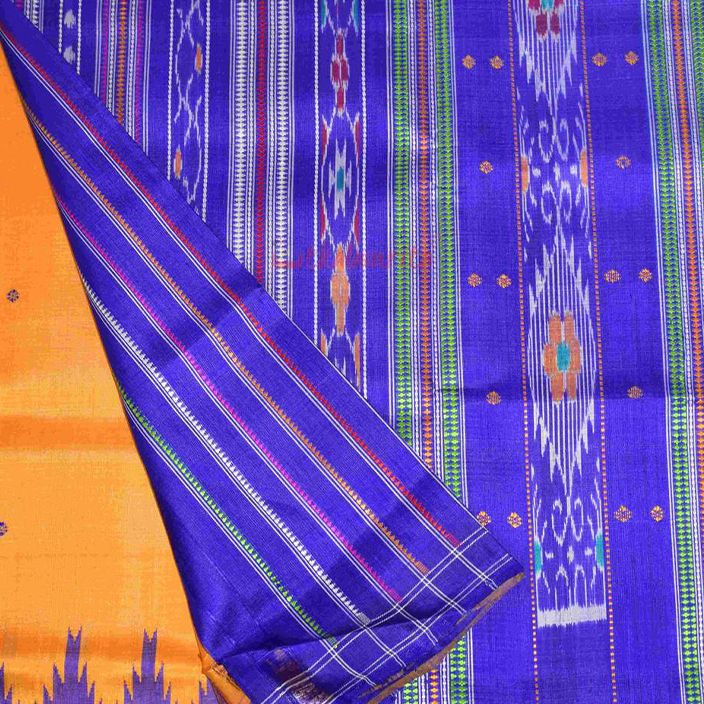For best prices and early deliveries, WhatsApp us at. 918488070070

Berhampuri Patta
In the historical state of Odhisha, another precious creation of exquisite local craftsmanship is the Berhampur Patta saree. This silk saree is known for its Odissi style and Kumbha, i.e., temple woven motifs. History says that the excellent weaving of these sarees has been famous during the Mohuri kingdom of the 14th century. Another unique feature of the Behrampuri Patta is that they are always made in pairs - where the saree is made for the women, and the joda that comes along with it is for the men (meant to be worn together). Colloquially known as the phoda kumbha, these sarees are true statement pieces with richly woven pallas and vibrant colors. Phoda kumbhas were once the pride of Odhisha and one of the most traditional pieces of clothing, but it has been found that there was a time when these were also exported to regions of Southeast Asia.
Tracing Its Origin
The origin of the Berhampur patta goes as back as the 14th century when the Mohuri King ruled the district of Ganjam. It is believed that this textile was introduced by the Mohuri King himself, who used the saree to adorn and worship Goddess "Mohuri Kahlua."
The fact that one saree takes up almost twenty days to develop makes it more clear why the royalty took an interest in it.
How It's Made
Conventionally, Berhampur pattas are made on pit looms with threads of pure silk. No machine is used in the process, and the weaver spends as long as twenty days to make one saree. A traditional Ganga Jamuna (temple) border is woven along the paar or border.
These sarees are absolutely the opposite of machine-made fast fashion products. Every piece is carefully handwoven until it reaches perfection. The most time-consuming part of the saree is making the palla, which is covered with intricate motifs.
The Berhampuri patta is one of the few local wonders that has been given the GI (Geographical indication) tag by the Government of India- which indicates that this art form is specific and significant to a particular location.
Significance and Symbolism
Odhisa's long-standing history and cultural significance are reflected in this region's arts and crafts. Fascinating folktales, mythology dating back to the Ramayana, and stories of all the Kings who have ruled this place and their dynasties- elements of everything come together in forms of embroideries, patterns and motifs; be it on a bomkai saree or the Berhampur patta.
Legend has it that at the time, only the Mohuri King was allowed to enter the temple of the deity Mohuri Kahlua, situated inside a secret cave. No local or ordinary man could enter the cave.
The King ordered the Berhampuri patta to worship the Goddess with this saree. The 200-year-old art of weaving these sarees has made it all the more special, giving Odhisha's weavers pride and recognition.
Design Elements
The intricate details, dainty zari work, and elaborate motifs indeed make these sarees one of a kind. A traditional phoda kumbha's design includes temple motifs running all along the bottom of the border – which has embroidery and woven patterns on it. The palla is richly woven with contrasting colours, generally matching the border, whereas, the overall body of the saree remains plain.
Berhampuri Patta is a handloom fabric from Berhampur, Odisha known for its intricate applique work and often used as a base for the embellished Paithani saree.
Berhampuri Patta Today
With time though, consumers' taste has changed, yet the Berhampuri silks remain a classic. Many designers have even tried to give their own spin to it, but any severe changes or revamping can completely take away the authenticity of these sarees. The only notable change that can be seen is the colour palette; in contrast to the stark and loud colours used in traditional Berhampuris, soft and pastel colours are now preferred. So, now you can shop for light shades like pastel pinks and yellows if deep colours are not your taste.
Image Credits
Wikiwand | Utkaladitiri | Twitter | The Explorer Of Miracles | Seerat | Orissa Post | Qrated By Harika | Orissa Handloom | My City Links | Kanchans Looms | Fashionary Shradha | Ethinc Lands | Facebook | Anita Explorer